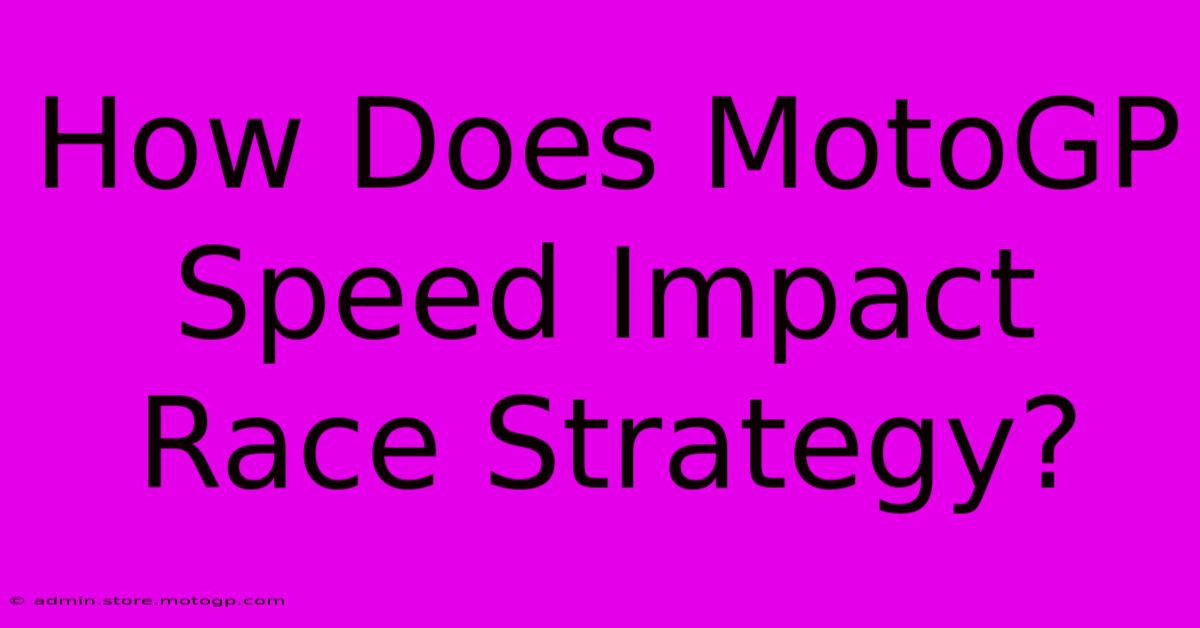How Does MotoGP Speed Impact Race Strategy?

Table of Contents
How Does MotoGP Speed Impact Race Strategy?
MotoGP racing, a breathtaking spectacle of speed and skill, isn't just about who has the fastest bike. Winning requires a sophisticated understanding of race strategy, intricately woven with the raw speed of the machines. The sheer velocity these bikes achieve profoundly impacts every decision a rider and team makes, from tire selection to fuel management and even overtaking maneuvers. Let's delve into the critical ways speed dictates MotoGP race strategy.
The Speed-Tire Relationship: A Delicate Balance
One of the most crucial aspects of MotoGP strategy revolves around tire selection and management. The incredible speeds reached on a MotoGP track, often exceeding 200 mph (320 km/h) on straights, put immense strain on tires. This high speed generates significant heat and wear, impacting grip and ultimately, lap times.
Choosing the Right Rubber
Teams meticulously analyze track conditions, temperature, and even the forecast to select the optimal tire compound for the race. Harder compounds offer greater durability at the cost of slightly slower lap times, while softer compounds provide superior grip but degrade faster. The strategic choice here is a delicate balance: maximize grip for faster laps early on or prioritize tire longevity for a consistent pace throughout the race? This decision is heavily influenced by the track's speed characteristics. High-speed circuits demand more durable tires to withstand the relentless forces.
Tire Degradation and Race Pace
The speed of the race directly impacts tire degradation. Faster speeds exacerbate tire wear, potentially leading to a dramatic drop in performance towards the end of the race. This necessitates a considered race pace. Pushing too hard early on might yield initial gains but could result in a catastrophic tire failure or a significant loss of grip, effectively ruining the race. Conversely, a conservatively slow pace might preserve tires, but it could leave the rider vulnerable to faster competitors.
Fuel Management: A Speed-Constrained Equation
Speed is an enemy of fuel efficiency. The higher the speed, the more fuel a MotoGP bike consumes. This necessitates precise fuel management strategies, particularly in races where the fuel load is restricted. Teams use sophisticated data analysis to determine the optimal fuel consumption strategy based on the track's speed profile. This involves calculating the ideal race pace to balance speed and fuel conservation.
Race Pace and Fuel Efficiency
Maintaining a consistent and efficient race pace is critical for managing fuel consumption. Unnecessary bursts of speed will rapidly deplete fuel reserves, leaving the rider short at the end of the race. This often means strategically adjusting speed based on track sections. For example, a rider might push harder on straights where fuel consumption is relatively lower compared to high-speed corners where tire wear and fuel efficiency both suffer.
Overtaking and Speed Advantage
Speed plays a dominant role in overtaking maneuvers. The ability to accelerate out of corners and maintain higher speeds on straights often determines the success or failure of an overtaking attempt. A superior top speed gives a rider a significant advantage in overtaking, especially on long straights.
Slipstreaming and Drafting
MotoGP riders frequently use slipstreaming (drafting) to gain speed and enhance their overtaking opportunities. By following closely behind another rider, they can reduce air resistance and gain a significant speed boost, making it easier to pass on the straights. The speed advantage gained through slipstreaming is heavily dependent on the track and the speed of the bikes involved.
Conclusion: Speed as a Strategic Determinant
In conclusion, speed is not merely a performance metric in MotoGP; it's a fundamental element shaping every aspect of race strategy. From tire selection and management to fuel conservation and overtaking techniques, the inherent speed of these machines dictates the choices made by riders and teams. Mastering the interplay between speed, tire wear, fuel efficiency, and overtaking is the key to achieving victory in the high-stakes world of MotoGP. The strategic mastery of speed ultimately distinguishes a winning team from the rest.

Thank you for visiting our website wich cover about How Does MotoGP Speed Impact Race Strategy?. We hope the information provided has been useful to you. Feel free to contact us if you have any questions or need further assistance. See you next time and dont miss to bookmark.
Featured Posts
-
How To Choose A Genuine Helmet Stay Safe On Your Bike
Feb 20, 2025
-
Yamaha Moto Gp Back To Winning Ways
Feb 20, 2025
-
Experience The Energy Of Cota Explore Hospitality
Feb 20, 2025
-
Motorcycle Race Austin Tx A Must See Event In Austin
Feb 20, 2025
-
Cotas Open Track Days Are You Ready
Feb 20, 2025
